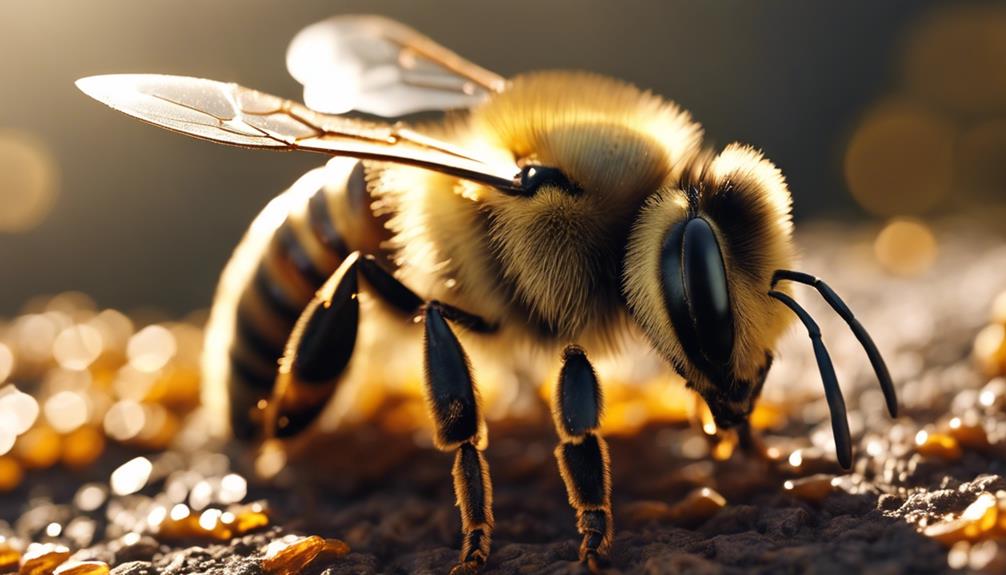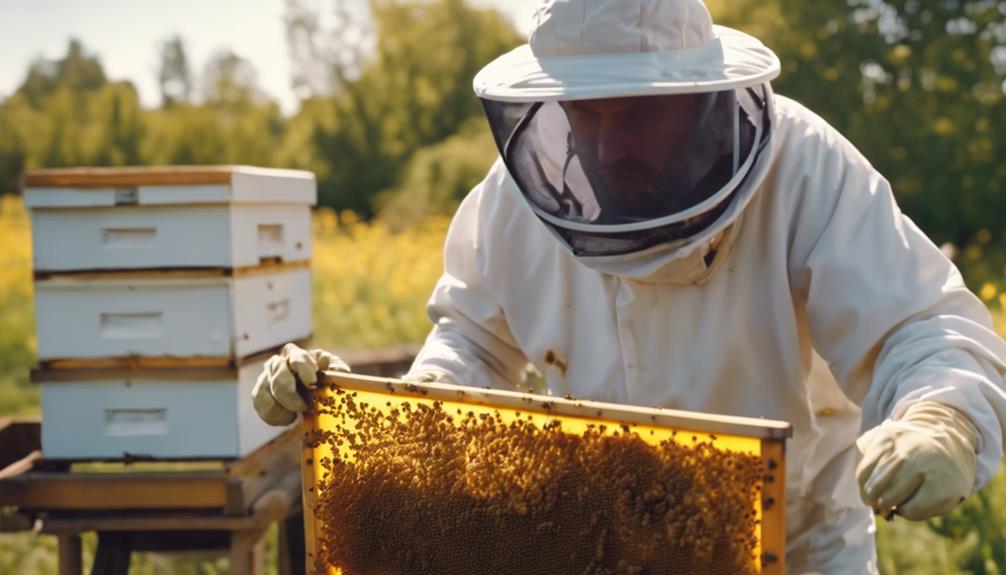When we smoke bees, it’s like hitting the pause button on their busy bee chats, which is a good thing because it stops them from getting all defensive and lets us work with them safely. The smoke tricks them into thinking there’s a honey emergency, so they chow down their stash and focus on staying chill. Plus, it keeps them busy buzzing about the hive, giving us room to do our thing without the risk of getting a bee line of stingers. Curious to know how this buzzworthy technique really works? Keep exploring to uncover the science behind bee smoking and master the art of beekeeping harmony.
Main Points
- Calms bees for safety during hive inspections.
- Disrupts alarm pheromones to prevent defensive responses.
- Masks alarm signals to reduce aggression.
- Promotes feeding response, diverting attention.
- Ensures efficiency and safety in beekeeping practices.
Importance of Smoking Bees
As beekeepers, we rely on smoking bees to disrupt their communication and prevent defensive responses, ensuring our safety and the well-being of the bees. When we approach a hive for inspections, the smoke acts as a barrier, calming the bees and allowing us to work without the risk of being stung.
The vital effect of smoke is remarkable; it triggers the bees to gorge on honey, making them less inclined to be aggressive. This process is essential during hive maintenance, as it keeps the bees occupied and less likely to see us as a threat.
How Smoke Calms Bees
When smoke wafts through a beehive, it muddles the bees’ ability to pick up on alarm pheromones, those chemical signals that usually set off their defense mechanisms.
This confusion prompts the bees to stock up on honey, preparing for a potential evacuation due to a nearby wildfire.
In this state of readiness, bees are less likely to lash out with stings, as their focus shifts to survival, keeping us beekeepers safe during hive inspections.
Smoke Inhibits Alarm Pheromones
Using smoke in beekeeping operations effectively calms bees by inhibiting the release of alarm pheromones that trigger defensive behaviors. When smoke interferes with bees’ communication, it hinders their ability to coordinate aggressive responses. This disruption creates a calmer environment for beekeepers during hive inspections.
By masking alarm pheromones, smoke helps prevent bees from mobilizing to attack, ensuring the safety of those working with the hives. The bees perceive the smell of smoke as a sign of a potential fire, prompting them to focus on consuming honey and preparing to leave the hive rather than stinging.
Incorporating smoke into hive management practices is essential for managing bee behavior and facilitating a more peaceful interaction between beekeepers and their hives.
Bee Feeding Response Affected
To understand how smoke calms bees, it’s essential to recognize that smoke triggers a feeding response in bees by simulating a wildfire threat. When bees sense smoke, their survival instinct kicks in, leading them to consume honey rapidly. This feeding response plays a key role in beekeeping, especially during hive inspections.
By inducing this behavior, smoke makes bees less likely to engage in defensive activities like stinging, allowing beekeepers to work with the hives more safely. The distraction caused by the smoke’s effect on their feeding response also helps beekeepers manipulate bee behavior for easier hive management.
Disrupts Bee Communication
How does smoke effectively calm bees in a beehive by disrupting their communication channels? When smoke is introduced, it interferes with bees’ ability to communicate through alarm pheromones, which are essential for signaling danger and coordinating defensive responses. Here’s how smoke achieves this calming effect:
- Smoke masks alarm pheromones, preventing bees from alerting others about potential threats.
- The disruption in communication hinders bees’ coordination in mounting a collective defense.
- By confusing bees and impeding their ability to convey specific messages, smoke creates a vital effect for beekeepers to work in, reducing the risk of aggressive behavior.
Through this masking of alarm signals, smoke plays an important role in maintaining harmony within the hive and facilitating safe beekeeping practices.
Bee Behavior and Smoke
Why do bees exhibit unique behaviors in response to smoke introduced into their hives?
When smoke enters the hive, it disrupts the bees’ communication by masking the alarm pheromones. This signals to the bees that a wildfire might be approaching, triggering a survival response.
The bees interpret this as a cue to prepare to leave the hive and consume honey, which they gorge on. This abundance of honey consumption actually calms the bees, making them less likely to sting.
For us beekeepers, using a smoker filled with fuel such as wood chips or pine needles is a common practice in beekeeping. Proper use of smoke helps us work in the hives without provoking defensive reactions from the bees.
Benefits of Using Smoke
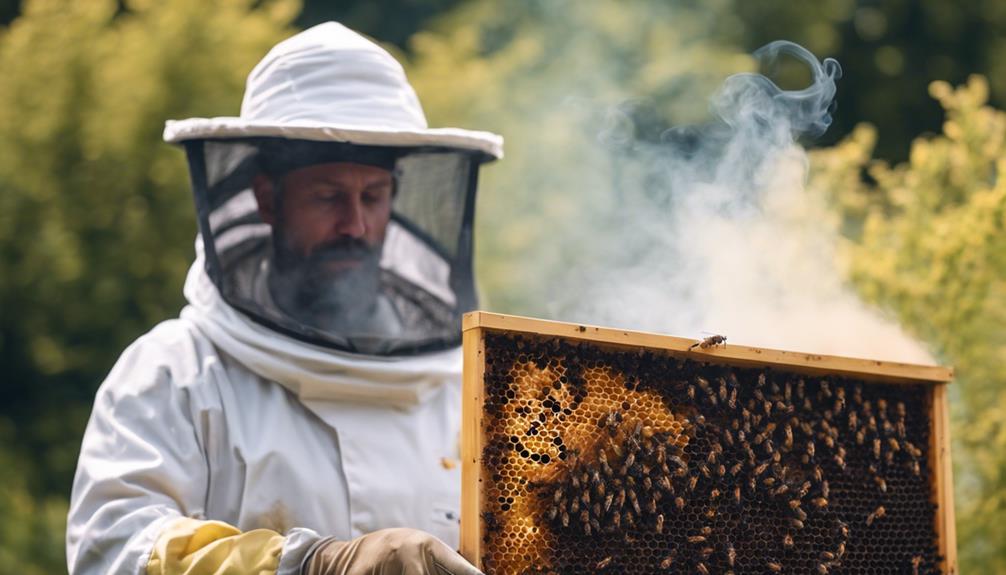
Using smoke in beekeeping operations provides essential advantages that contribute to the safety and efficiency of hive maintenance tasks.
When beekeepers use smoke, it calms bees and makes them less defensive, reducing their aggressive responses. This traditional method is a key security measure during hive inspections, as it interferes with bees’ ability to detect alarm pheromones, leading to reduced defensive behavior.
Additionally, the smoke triggers bees to consume honey, further pacifying them and making it less likely for beekeepers to get stung. By understanding the benefits of using smoke, beekeepers can guarantee a smoother and safer experience when working with their hives.
The Science Behind Bee Smoking
Bee smoking operates by disrupting bees’ sense of smell, an essential element in their communication and defensive mechanisms. When we introduce smoke near the hive, it masks the alarm pheromones, preventing the bees from signaling danger effectively. Instead of gearing up to sting, the bees instinctively start feasting on honey. This diversion keeps them busy and less likely to attack during hive inspections.
For us beekeepers, smoke is like a magician’s trick, redirecting the bees’ attention with the illusion of a distant wildfire. It’s not about causing harm; it’s about ensuring safety and efficiency in managing the hive. By understanding the science behind bee smoking, we can work harmoniously with these incredible insects for the benefit of both parties.
Proper Techniques for Smoking Bees
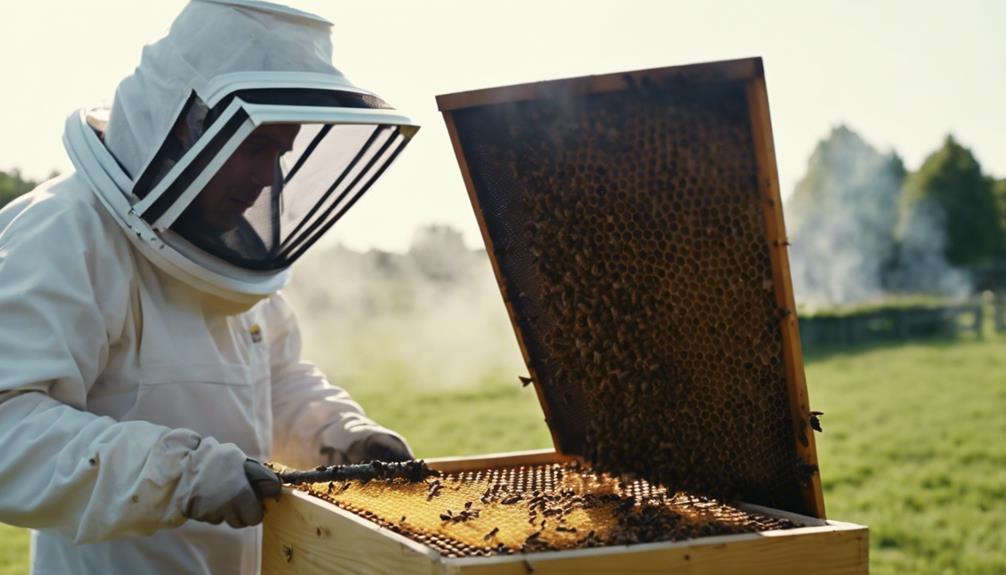
In regards to smoking bees, ensuring safety is paramount. Proper equipment and timing play essential roles in the process.
Let’s investigate the vital points of safety when smoking bees, the required equipment, and the ideal timing and frequency for this beekeeping practice.
Safety When Smoking Bees
Proper techniques for smoking bees play an important role in ensuring beekeeper safety and maintaining a calm hive environment during inspections.
In terms of safety while smoking bees, there are a few key things to keep in mind:
- Using the right amount of smoke: Helps in calming bees and reducing defensive responses.
- Puffing smoke at the hive entrance: Prepares the bees for inspection and minimizes disruptions.
- Moderation is key: Balancing between calming the bees and avoiding overexposure is essential for a successful hive inspection.
Equipment for Smoking Bees
To effectively calm bees and maintain a peaceful hive environment during inspections, the equipment for smoking bees should consist of a bellow, nozzle, and fire chamber for best smoke delivery. When using a bee smoker, selecting the right fuel is essential. Wood shavings, pine needles, or even cardboard can create the perfect smoke. Initiating the fire with newspaper or cardboard guarantees a steady burn that keeps the bees calm.
During hive inspections, allow the smoke to work its magic for about 10 minutes to block out alarm pheromones and promote safe hive maintenance. The design and operation of the bee smoker are all geared towards creating an atmosphere where bees feel relaxed, making your inspections smoother and less stressful for both you and the bees.
Timing and Frequency
Using cool smoke is essential for calming bees effectively and ensuring their safety during hive inspections. Timing plays a vital role in smoking bees, with smoke ideally applied a few minutes before opening the hive to allow the bees to settle down.
Frequent smoking should be avoided to prevent unnecessary stress on the colony. When smoking bees, remember to use cool smoke to achieve the desired calming effect without harming the bees. Smoking bees too often can disrupt the hive’s natural processes and communication, impacting their overall well-being.
Safety Measures When Smoking Bees
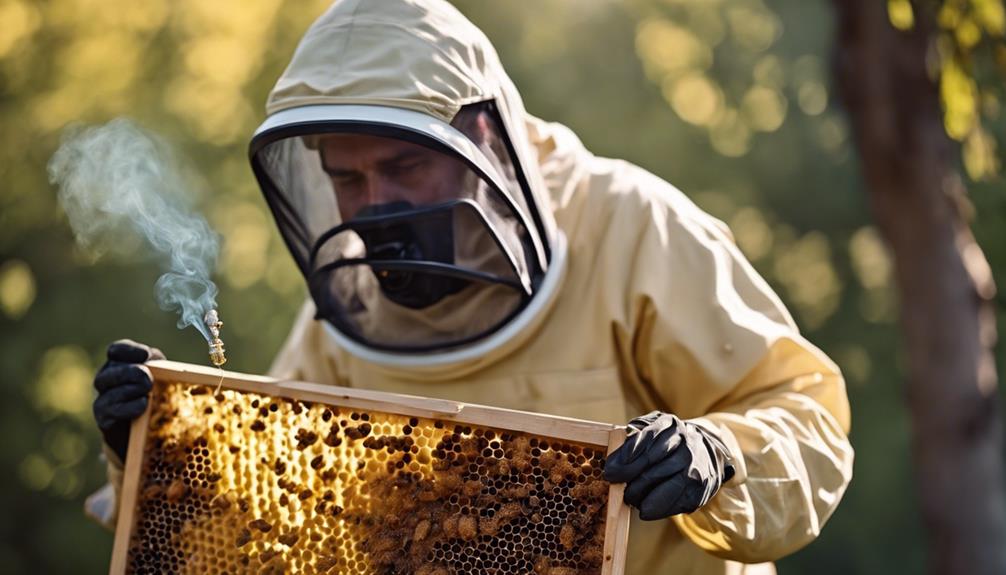
When smoking bees, it’s essential to prioritize safety measures such as wearing protective gear like bee suits and gloves to prevent stings. Ensuring proper ventilation is vital to avoid inhaling excessive smoke. Remember to keep a safe distance from the hive entrance when smoking bees to prevent agitation.
It’s wise to have a fire extinguisher nearby in case of accidental fires. Always follow the manufacturer’s instructions for operating and maintaining the bee smoker to prevent accidents. These precautions not only protect you but also ensure a smooth beekeeping experience.

Roger Thomas is a seasoned beekeeper and hive architect with a deep-seated passion for sustainable living. His fascination with bees has shaped his professional career, giving him practical and theoretical expertise in bee behavior, colony health, and optimal hive conditions. Roger’s technical skills shine in his bespoke hive creations that cater to the specific needs of diverse bee species, while his sustainable practices promote environmental balance and the wellbeing of the bee population.
As he continues his journey in beekeeping, Roger has become a dedicated advocate for responsible practices and an insightful educator in his field. His posts aim to inspire new beekeepers, underline the importance of sustainability, and showcase the remarkable contribution bees make to our ecosystem. Roger invites you to join him as he delves into the world of bees and the rewarding, honey-sweet art of beekeeping.

